Residual Magnetic Field Testing System with Tunneling Magneto-Resistive Arrays for Crack Inspection in Ferromagnetic Pipes
Abstract
1. Introduction
- (1)
- An RMFT system is developed to detect the cracks in ferromagnetic pipes. An array of permanent magnets and TMR sensors are applied to build a detection probe, which can implement pipe for magnetization and signal acquisition simultaneously.
- (2)
- An experiment is conducted using the designed RMFT system. The characteristics ΔBx and lx in RMFT signals can be used to express the crack size (length and depth), which validates the feasibility of the RMFT method.
2. Theoretical Analysis
2.1. Physics Principle
2.2. Finite Element Model
2.3. Signature Waveform Analysis
3. Experimental Setup and Results
3.1. RMFT System
3.2. Results Analysis and Discussion
4. Conclusions
Author Contributions
Funding
Institutional Review Board Statement
Informed Consent Statement
Data Availability Statement
Acknowledgments
Conflicts of Interest
References
- Sharma, S.K.; Maheshwari, S. A review on welding of high strength oil and gas pipeline steels. J. Nat. Gas Sci. Eng. 2017, 38, 203–217. [Google Scholar] [CrossRef]
- Kim, M.; Ha, J.; Kim, Y.-T.; Choi, J. Stainless steel: A high potential material for green electrochemical energy storage and conversion. Chem. Eng. J. 2022, 440, 135459. [Google Scholar] [CrossRef]
- Shi, Y.; Zhang, C.; Li, R.; Cai, M.; Jia, G. Theory and Application of Magnetic Flux Leakage Pipeline Detection. Sensors 2015, 15, 31036–31055. [Google Scholar] [CrossRef]
- Piao, G.; Guo, J.; Hu, T.; Leung, H.; Deng, Y. Fast reconstruction of 3-D defect profile from MFL signals using key physics-based parameters and SVM. NDT E Int. 2019, 103, 26–38. [Google Scholar] [CrossRef]
- Wang, Z.D.; Gu, Y.; Wang, Y.S. A review of three magnetic NDT technologies. J. Magn. Magn. Mater. 2012, 324, 382–388. [Google Scholar] [CrossRef]
- Zhao, S.; Shen, Y.; Wang, J.; Jiang, Z.; Mao, Z.; Chu, Z.; Gao, J. A Defect Visualization Method Based on ACFM Signals Obtained by a Uniaxial TMR Sensor. IEEE Sens. J. 2023, 23, 265–273. [Google Scholar] [CrossRef]
- Wu, J.; Yang, F.; Jing, L.; Liu, Z.; Lin, Y.; Ma, H. Defect detection in pipes using Van der Pol systems based on ultrasonic guided wave. Int. J. Press. Vessel. Pip. 2022, 195, 104577. [Google Scholar] [CrossRef]
- Feng, Q.S.; Li, R.; Nie, B.H.; Liu, S.C.; Zhao, L.Y.; Zhang, H. Literature Review: Theory and Application of In-Line Inspection Technologies for Oil and Gas Pipeline Girth Weld Defection. Sensors 2017, 17, 50. [Google Scholar] [CrossRef]
- Yu, Z.; Fu, Y.; Jiang, L.; Yang, F. Detection of circumferential cracks in heat exchanger tubes using pulsed eddy current testing. NDT E Int. 2021, 121, 102444. [Google Scholar] [CrossRef]
- Zhao, J.; Li, W.; Yuan, X.; Yin, X.; Ding, J.; Chen, Q.; Yang, H. Rotating alternating current field measurement testing system with TMR arrays for arbitrary-angle crack on nonferromagnetic pipes. Meas. Sci. Technol. 2023, 34, 015109. [Google Scholar] [CrossRef]
- Hayt, W.H.; Buck, J.A. Engineering Electromagnetics; McGraw-Hill Companies, Inc.: New York, NY, USA, 2012. [Google Scholar]
- Betta, G.; Ferrigno, L.; Laracca, M.; Rasile, A.; Sangiovanni, S. A novel TMR based triaxial eddy current test probe for any orientation crack detection. Measurement 2021, 181, 109617. [Google Scholar] [CrossRef]
- Zhao, S.; Shen, Y.; Sun, L.; Wang, J.; Mao, Z.; Chu, Z.; Chen, J.; Gao, J. A method to compensate for the lift off effect of ACFM in crack estimation of nonferromagnetic metals. J. Magn. Magn. Mater. 2022, 554, 169301. [Google Scholar] [CrossRef]
- Lee, J.; Jun, J.; Kim, J.; Choi, H.; Le, M. Bobbin-Type Solid-State Hall Sensor Array With High Spatial Resolution for Cracks Inspection in Small-Bore Piping Systems. IEEE Trans. Magn. 2012, 48, 3704–3707. [Google Scholar] [CrossRef]
- He, D.F.; Shiwa, M.; Jia, J.P.; Takatsubo, J.; Moriya, S. Multi-frequency ECT with AMR sensor. NDT E Int. 2011, 44, 438–441. [Google Scholar] [CrossRef]
- Ye, C.F.; Huang, Y.; Udpa, L.; Udpa, S.S. Novel Rotating Current Probe With GMR Array Sensors for Steam Generate Tube Inspection. IEEE Sens. J. 2016, 16, 4995–5002. [Google Scholar] [CrossRef]
- Yuan, X.; Li, W.; Chen, G.; Yin, X.; Jiang, W.; Zhao, J.; Ge, J. Inspection of both inner and outer cracks in aluminum tubes using double frequency circumferential current field testing method. Mech. Syst. Signal Process. 2019, 127, 16–34. [Google Scholar] [CrossRef]
- Hayakawaa, J.; Ikeda, S.; Lee, Y.M.; Matsukura, F.; Ohno, H. Effect of high annealing temperature on giant tunnel magnetoresistance ratio of CoFeB/MgO/CoFeB magnetic tunnel junctions. Appl. Phys. Lett. 2006, 89, 232510. [Google Scholar] [CrossRef]
- Li, X.Y.; Hu, J.P.; Chen, W.P.; Yin, L.; Liu, X.W. A Novel High-Precision Digital Tunneling Magnetic Resistance-Type Sensor for the Nanosatellites’ Space Application. Micromachines 2018, 9, 121. [Google Scholar] [CrossRef]
- Yang, L.; Cui, W.; Liu, B.; Gao, S. A pipeline defect detection technique based on residual magnetism effect. Oil Gas Storage Transp. 2015, 34, 714–718. [Google Scholar]
- Chen, D.-X.; Pardo, E.; Zhu, Y.-H.; Xiang, L.-X.; Ding, J.-Q. Demagnetizing correction in fluxmetric measurements of magnetization curves and hysteresis loops of ferromagnetic cylinders. J. Magn. Magn. Mater. 2018, 449, 447–454. [Google Scholar] [CrossRef]
- Ge, J.; Li, W.; Chen, G.; Yin, X.; Wu, Y.; Liu, J.; Yuan, X. Analysis of signals for inclined crack detection through alternating current field measurement with a U-shaped probe. Insight-Non Destr. Test. Cond. Monit. 2017, 59, 121–128. [Google Scholar] [CrossRef]
- GB/T 8163-2018; Seamless Steel Pipes for Liquid Service. National Standardization Administration of the P.R.C: Beijing, China, 2018.
- Chen, L.; Li, X.B.; Qin, G.X.; Lu, Q. Signal processing of magnetic flux leakage surface flaw inspect in pipeline steel. Russ. J. Nondestruct. Test. 2008, 44, 859–867. [Google Scholar] [CrossRef]
- Zhao, S.; Sun, L.; Gao, J.; Wang, J.; Shen, Y. Uniaxial ACFM detection system for metal crack size estimation using magnetic signature waveform analysis. Measurement 2020, 164, 108090. [Google Scholar] [CrossRef]
- Zhao, S.; Shen, Y.; Wang, J.; Zhu, R.; Zhai, W.; Dong, H.; Mao, Z.; Gao, J. Extreme learning machine based sub-surface crack detection and quantification method for ACFM. J. Magn. Magn. Mater. 2022, 546, 168865. [Google Scholar] [CrossRef]






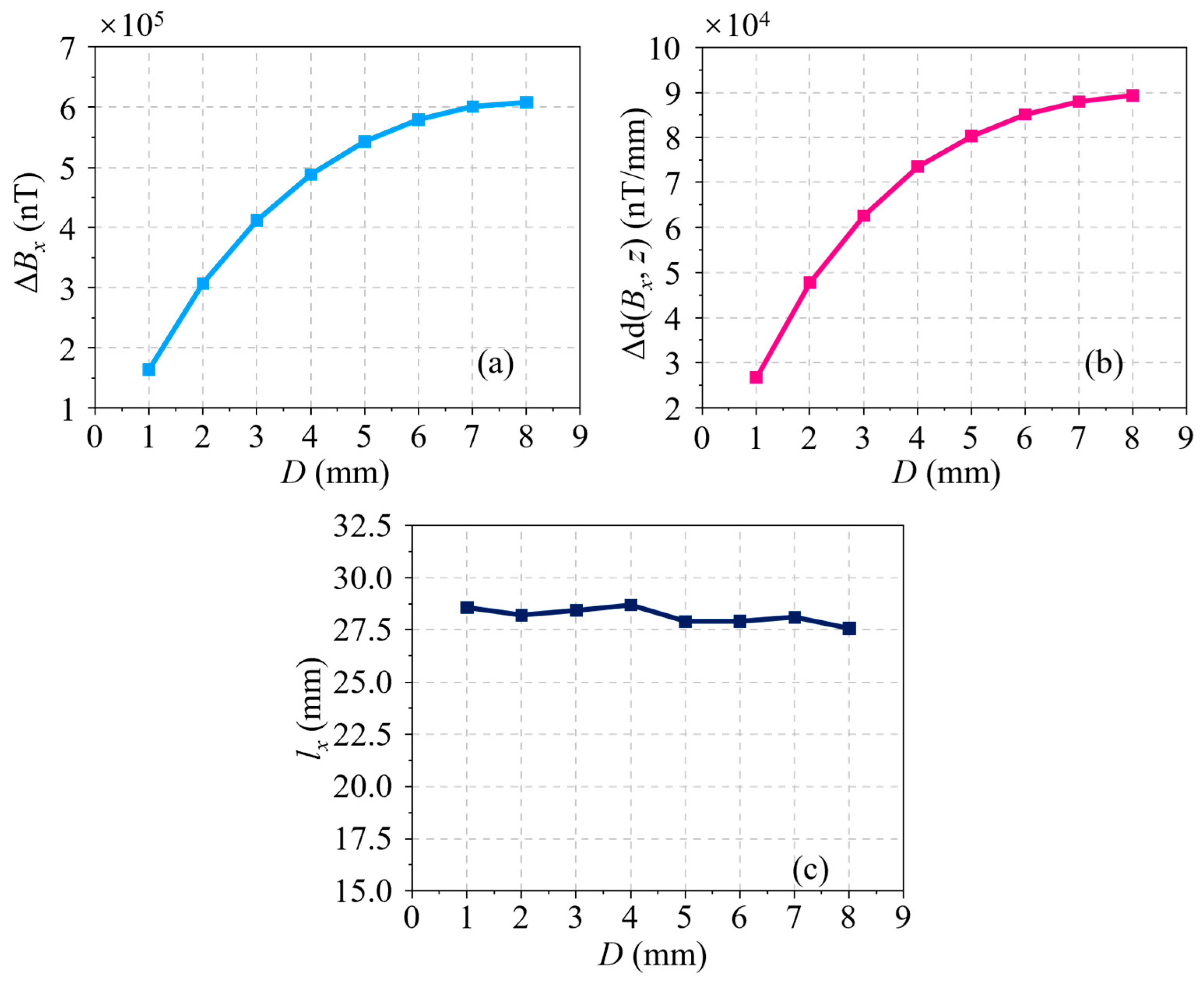
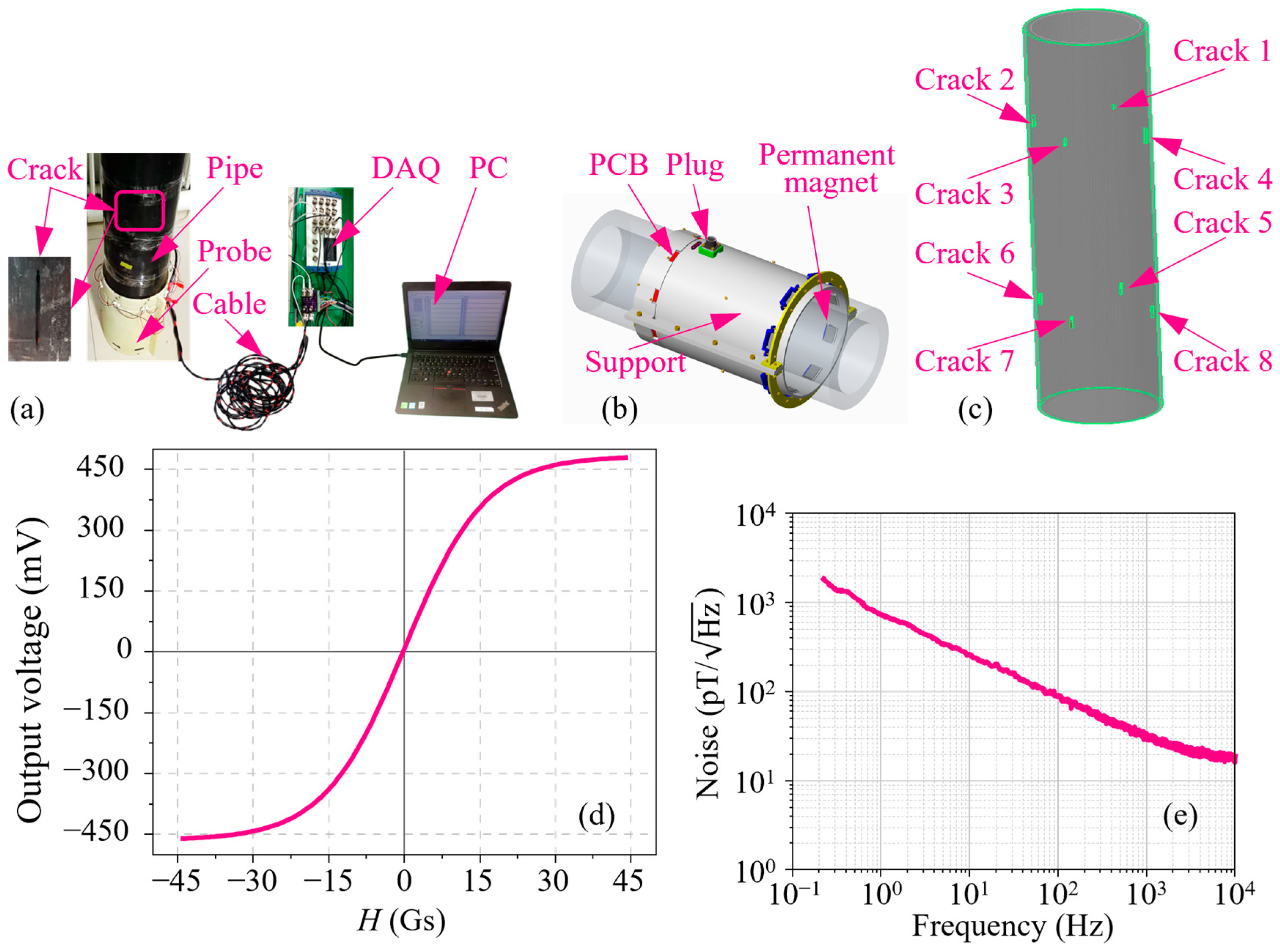

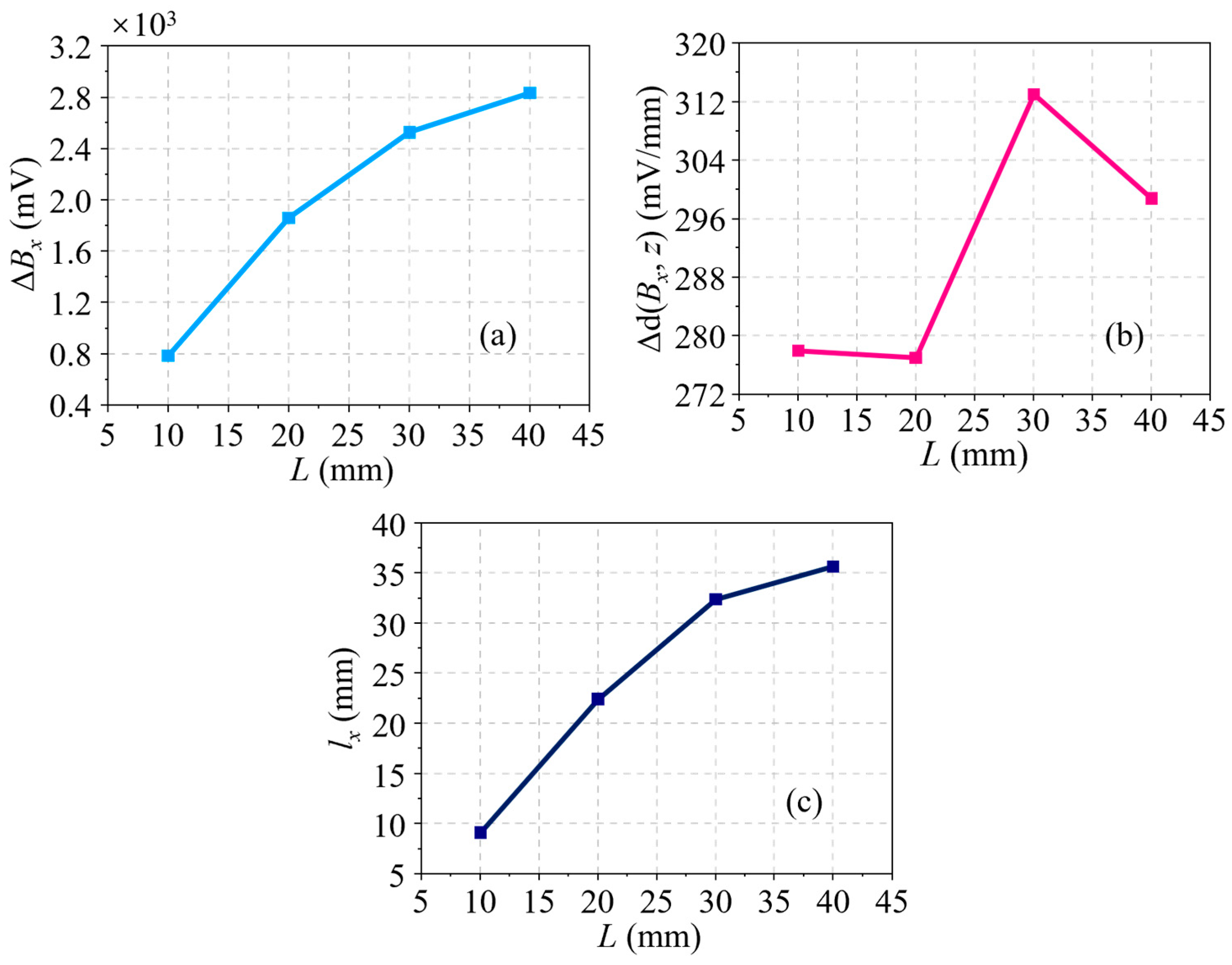
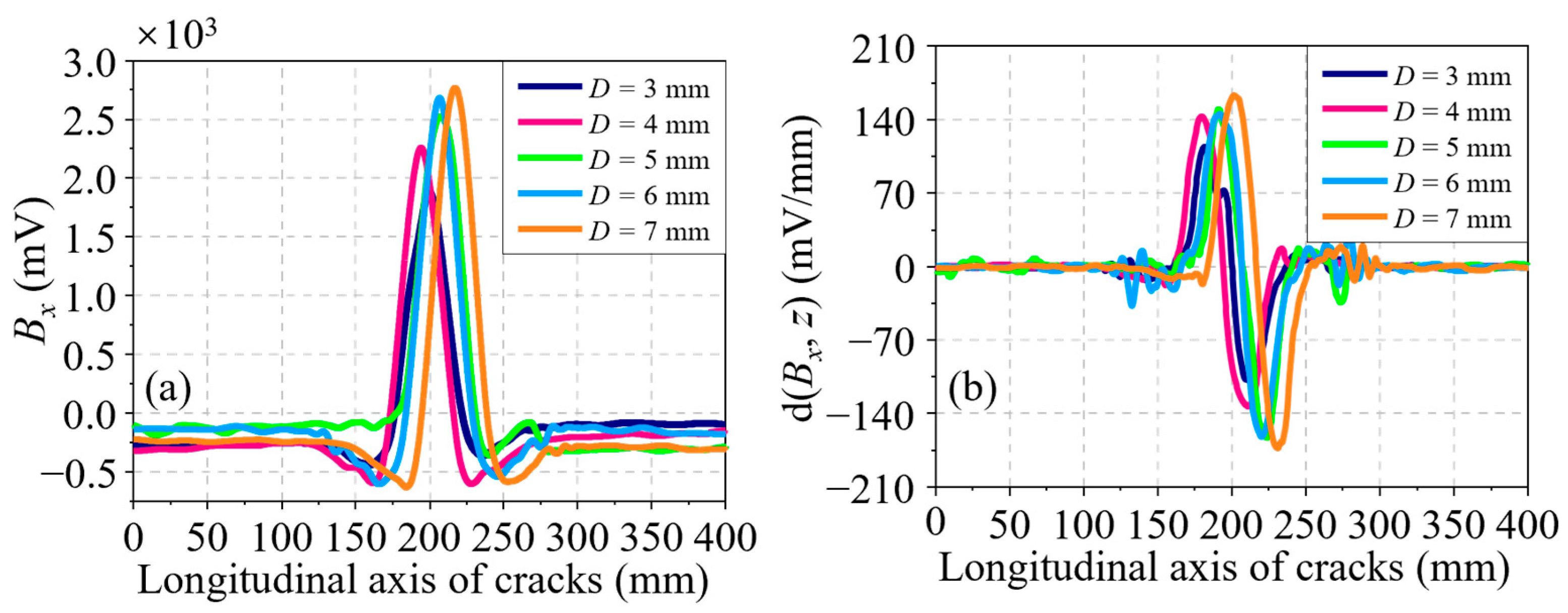
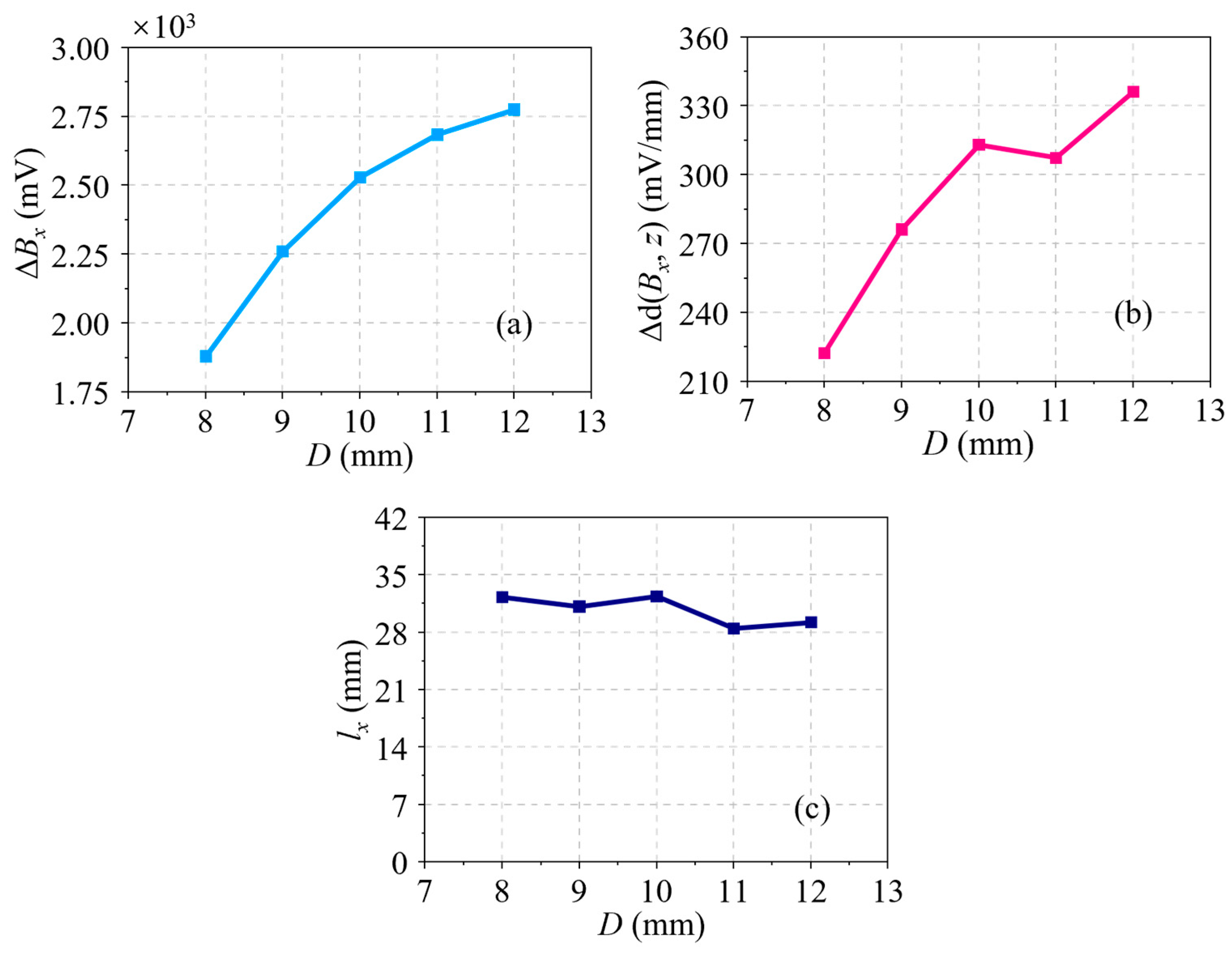
| Model | Material | Relative Permeability | Residual Magnetic Flux Density (Gs) |
|---|---|---|---|
| Infinite element domain | Air | 1 | - |
| Magnetized domain | Carbon steel | 1000 [22] | 300.00 |
| Pipe | Carbon steel | 1000 | - |
| Crack | Air | 1 | - |
| Others | Air | 1 | - |
| Model | Diameter (mm) | L (mm) | W (mm) | D (mm) | Thickness (mm) |
|---|---|---|---|---|---|
| Infinite element domain | 1000.00 | - | - | - | 100.00 |
| Magnetized domain | - | 500.00 | 30.00 | 8.00 | - |
| Pipe | 200.00 | 500.00 | - | - | 8.00 |
| Crack | - | Varied | 1.00 | Varied | - |
| Crack | L (mm) | D (mm) | Crack | L (mm) | D (mm) |
|---|---|---|---|---|---|
| 1 | 10.00 | 5.00 | 5 | 30.00 | 7.00 |
| 2 | 30.00 | 5.00 | 6 | 30.00 | 6.00 |
| 3 | 20.00 | 5.00 | 7 | 30.00 | 4.00 |
| 4 | 40.00 | 5.00 | 8 | 30.00 | 3.00 |
Disclaimer/Publisher’s Note: The statements, opinions and data contained in all publications are solely those of the individual author(s) and contributor(s) and not of MDPI and/or the editor(s). MDPI and/or the editor(s) disclaim responsibility for any injury to people or property resulting from any ideas, methods, instructions or products referred to in the content. |
© 2024 by the authors. Licensee MDPI, Basel, Switzerland. This article is an open access article distributed under the terms and conditions of the Creative Commons Attribution (CC BY) license (https://creativecommons.org/licenses/by/4.0/).
Share and Cite
Zhao, S.; Gao, J.; Chen, J.; Pan, L. Residual Magnetic Field Testing System with Tunneling Magneto-Resistive Arrays for Crack Inspection in Ferromagnetic Pipes. Sensors 2024, 24, 3259. https://doi.org/10.3390/s24113259
Zhao S, Gao J, Chen J, Pan L. Residual Magnetic Field Testing System with Tunneling Magneto-Resistive Arrays for Crack Inspection in Ferromagnetic Pipes. Sensors. 2024; 24(11):3259. https://doi.org/10.3390/s24113259
Chicago/Turabian StyleZhao, Shuxiang, Junqi Gao, Jiamin Chen, and Lindong Pan. 2024. "Residual Magnetic Field Testing System with Tunneling Magneto-Resistive Arrays for Crack Inspection in Ferromagnetic Pipes" Sensors 24, no. 11: 3259. https://doi.org/10.3390/s24113259
APA StyleZhao, S., Gao, J., Chen, J., & Pan, L. (2024). Residual Magnetic Field Testing System with Tunneling Magneto-Resistive Arrays for Crack Inspection in Ferromagnetic Pipes. Sensors, 24(11), 3259. https://doi.org/10.3390/s24113259






